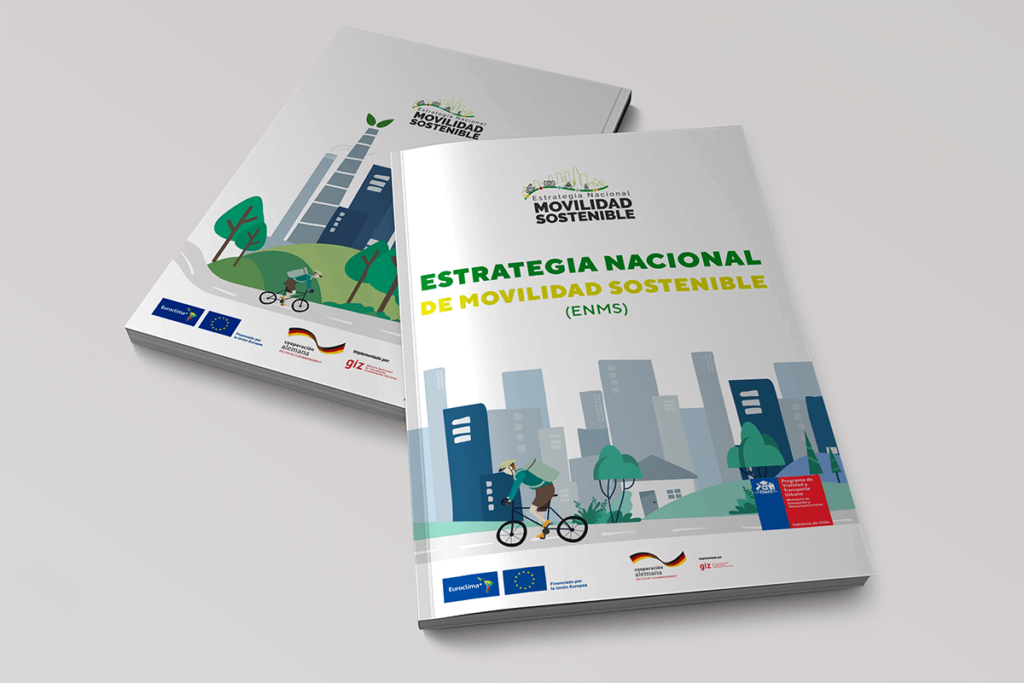
Through the SECTRA Programme of the Ministry of Transports and Telecommunications, the Government of Chile launched its National Strategy for Sustainable Mobility (ENMS), a public policy document that includes the vision, objectives and measures to articulate the different actors involved in this area. This, through a roadmap that will address the main gaps and challenges of moving towards sustainable mobility in Chile.
The development of this Strategy is part of the cooperation project with Chile of the EUROCLIMA+ programme, financed by the European Union, and implemented with the technical assistance of GIZ.
This framework project includes three components or areas of development:

The Strategy sets the technical and political guidelines for the local implementation of sustainable mobility measures through the definition of key concepts, the identification of the main challenges at the country level in this area, the generation of a long-term vision, the introduction of the necessary change approach, the specific objectives of the Strategy, and finally, the selection and description of measures, as well as their possible implementation mechanisms. It is a guiding document for the design of the investment program, which will act as a tool for implementing the Strategy.
“Our vision is that by the year 2050, Chile will have transportation systems and urban development that together allow for sustainable and fair mobility in our cities. To leave no one behind and for cities to be an engine of equitable development,”
Gisèle Labarthe, Executive Secretary of SECTRA

The Strategy had an elaboration process of approximately three years, including developing an exhaustive diagnostic document of the state of sustainable mobility in Chile, the dialogue between different sectoral actors, and the technical support for the consolidation of the document by a specialized consultant.
From its conception, the Strategy aims at a multi-sectoral approach. It complements other existing strategies in the sector, such as the Electromobility Strategy. At the same time, it is linked to laws and policies of other sectors such as urban development, housing, health, energy and others, that together generate an important link between the sector and the commitments and definitions that the country has assumed for the mitigation and adaptation of the climate crisis and the Nationally Determined Contributions (NDC) of Chile.
“What they are raising concerning coordination, to how we work, to the fact that this is not a single solution, is something that touches on the Long Term Climate Strategy. It recognizes the National Strategy for Sustainable Mobility and how Transport, together with other ministries, is going to advance in this,” added Carolina Urmeneta, head of the climate change office at the Ministry of the Environment.
“What they are raising concerning coordination, to how we work, to the fact that this is not a single solution, is something that touches on the Long Term Climate Strategy. It recognizes the National Strategy for Sustainable Mobility and how Transport, together with other ministries, is going to advance in this,”
Carolina Urmeneta, Head of the Climate Change Office at the Ministry of Environment , Chile

Urban mobility is responsible for a significant part of the greenhouse gas (GHG) emissions that contribute to climate change and is one of the fastest growing sectors in recent years.
Within the framework of international agreements to reduce greenhouse gas (GHG) emissions, Chile has committed to reaching its maximum annual emissions in 2025, implying that it must reduce its annual emissions by at least 24% of what it emitted in 2018. An essential part of this effort must come from the transport sector.
During the launch event, Gloria Hutt, Minister of Transport and Telecommunications, presented an overview of Chile’s transport and mobility challenges and how the National Sustainable Mobility Strategy seeks to address them.
23% of the emissions that we have to reduce come from the transportation sector. We have an immense responsibility to find the lines of work that will allow us to reduce these emissions effectively”.
The ENMS allows the generation of action points and clear goals to achieve carbon neutrality in the sector through concrete measures.

The following steps for the project are to establish the strategies for implementing the ENMS, initiate the design of the investment program and strengthen the linkage with new stakeholders. These processes will be carried out during the first half of 2022. The program’s design will be accompanied by a participatory process that will identify and identify differentiated trends and priorities at the territorial level to achieve sustainable mobility at the city scale. This programme will identify mechanisms to finance concrete actions to facilitate the transition to carbon neutral mobility, providing criteria and guidelines for regions and cities to set their priorities and specific goals. In addition, the programme, which will be framed within the national investment system, will allow the ENMS to be projected in the long term, generating a way to access financing and develop projects at an appropriate standard.
You can download the National Strategy for Sustainable Mobility here
“We are building this strategy to achieve the goal that the country has committed to and that the next generations expect to see realized as a contribution and a responsibility that we have had to give,”
Gloria Hutt, Ministry of Transports and Telecommunications of Chile
This Strategy is the first step to advance towards sustainable mobility in Chile. It opens a space for multi-sectoral collaboration in which coordination at horizontal and vertical levels will be necessary, an opportunity favoured in strengthening decentralization in Chile. Of course, there is a diversity of challenges. However, this Strategy establishes a look from the sector and a request to start the transition with them.
You are currently viewing a placeholder content from X. To access the actual content, click the button below. Please note that doing so will share data with third-party providers.
More Information